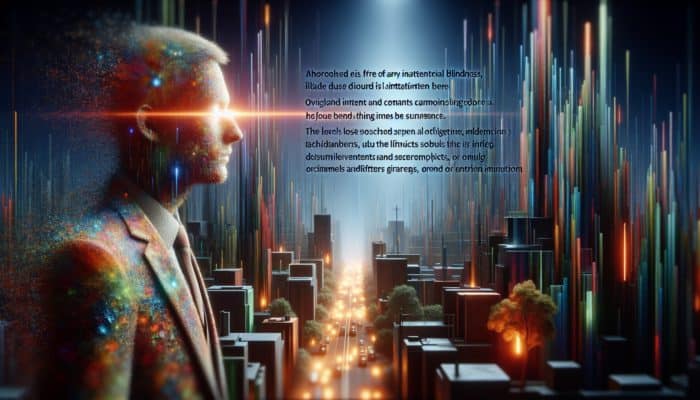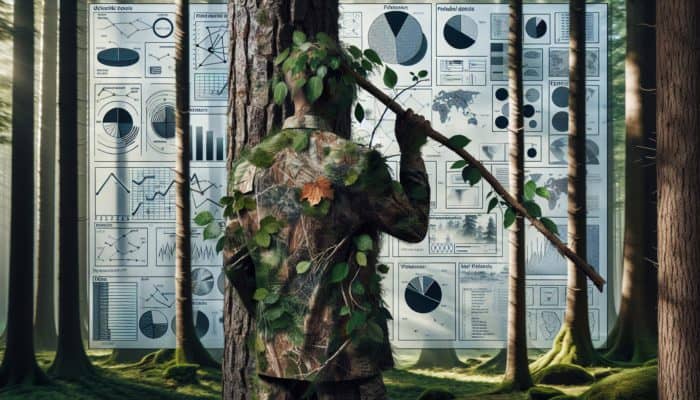Exploring the Intriguing Psychology of Concealment in Plain Sight
Understanding Cognitive Blindness and Human Perception

Hiding in Plain Sight: Cognitive blindness represents a captivating psychological phenomenon in which the human brain fails to process information that is literally right in front of it. This occurs due to various forms of inattentional blindness or change blindness, in which elements within our field of vision go unnoticed because they do not capture our attention. The brain, in its effort to filter out irrelevant noise and concentrate on what it considers important, can easily overlook significant details, thereby creating a powerful opportunity for concealment. Common examples of cognitive blindness include:
- Failing to notice a change in a familiar scene, such as a friend's new haircut.
- Not seeing a car merging into traffic while concentrating on the road ahead.
- Overlooking a specific product on a crowded supermarket shelf, despite passing it regularly.
- Missing a person dressed in the same colour as the surrounding environment in a photograph.
These examples highlight the paradox of perception: what we see is not necessarily what actually exists. Gaining a deeper understanding of this phenomenon not only illuminates our everyday oversights but also informs the techniques employed by those who master the art of hiding in plain sight.
How Familiarity Influences Concealment Techniques
Familiarity can be a double-edged sword in perception. On one hand, it fosters comfort and security; on the other, it can lead to significant oversight. When we grow accustomed to certain environments, our brains instinctively filter out elements we perceive as unimportant, creating openings for effective concealment. Consider a local park or a neighbourhood street that you have traversed countless times. Over time, your perception narrows, making it easy to miss crucial details—like an unmarked door or changes in landscaping—until someone brings them to your attention. The very essence of hiding in plain sight thrives on this sense of familiarity; the mundane becomes invisible, and strategic placement can yield substantial concealment. For example, artists frequently leverage familiar settings to embed their work within the landscape, effectively making the art a part of the environment rather than an object of focus.
What Psychological Triggers Help Us Notice the Hidden?
To successfully notice what remains hidden in plain sight, one must engage certain psychological triggers. Curiosity is undoubtedly one of the most potent of these triggers. When individuals feel intrigue or wonder, they are more inclined to look deeper and explore beyond the surface. Additionally, heightened awareness—often achieved through practices like mindfulness or specialised training—can sharpen one’s perception. Specific cues, such as sudden movements, unexpected sounds, or contrasting colours, can signal overlooked elements. For instance, in a magic trick, a well-placed distraction diverts viewers’ eyes, allowing the magician to perform a feat of concealment. In this context, we witness the synergy of psychology and situational awareness, functioning as powerful tools that reveal the hidden while allowing others to remain oblivious.
The Influence of Social Conditioning on Visibility Perception

Social conditioning plays a pivotal role in shaping what we perceive as deserving of our attention. Societal norms and expectations dictate our focus, often leading to significant oversights. For example, in urban environments, individuals may overlook street art, dismissing it as mere graffiti rather than a legitimate form of expression, thus making it easier to hide in plain sight. The societal lens through which we view our surroundings often leads to the neglect of elements that do not conform to established norms. This phenomenon is evident across various cultural contexts—what is celebrated in one society may be disregarded in another. Understanding these dynamics enables the formulation of strategic concealment techniques that exploit social biases, ensuring that what is hidden seamlessly integrates into everyday life. As we delve into the implications of these norms, it becomes evident that the art of hiding in plain sight extends beyond physical camouflage; it also encompasses profound psychological and social dimensions.
Insights from Experts on Effective Concealment Techniques
Examining Real-World Examples of Successful Concealment
Real-world examples of hiding in plain sight provide invaluable insights into effective concealment strategies. Consider the art of camouflage employed by military forces worldwide. The U.S. military utilises specialised patterns that closely mimic natural environments, allowing soldiers to blend seamlessly with their surroundings. This technique has proven effective across diverse terrains—from dense jungles to arid deserts—demonstrating the power of design in achieving concealment. Another notable example lies in the use of urban architecture in cities such as Tokyo, where entire buildings are cleverly disguised within the skyline. These structures often incorporate reflective materials or colour schemes that make them appear as mere extensions of the urban landscape, thereby concealing their true purpose from the casual observer. The outcomes of such techniques underscore the effectiveness of strategic design in both military and civilian contexts, highlighting the critical relationship between environment and visibility.
What Actionable Steps Can Enhance Concealment Techniques?

Implementing effective concealment techniques requires a thoughtful and strategic approach. Here is a comprehensive list of actionable steps that can significantly enhance your ability to hide in plain sight:
- Assess your environment: Take time to understand your surroundings thoroughly, noting patterns, colours, and typical movement.
- Utilise camouflage: Opt for colours and patterns that blend seamlessly into the environment, mimicking natural elements.
- Create distractions: Employ noise or movement elsewhere to divert attention from what you wish to conceal.
- Change your angles: Frequently alter your perspective; what may be visible from one angle could easily be hidden from another.
By incorporating these practical steps, individuals or organisations can dramatically improve their concealment skills. It is not merely about hiding; it is about mastering the environment and understanding the intricacies of perception.
Expert Analysis on the Psychology of Concealment Techniques
Understanding the psychological aspects of concealment is paramount to mastering the art of hiding in plain sight. The human brain operates on heuristics—mental shortcuts that simplify decision-making and perception. Consequently, individuals often rely on preconceived notions to navigate their surroundings, leading to predictable oversights. By leveraging psychological principles such as selective attention and change blindness, one can formulate strategies that exploit these cognitive tendencies. For instance, a store owner might frequently rearrange displays to ensure that loyal customers overlook new products. This manipulation of psychology cultivates a sense of familiarity while simultaneously enhancing the effectiveness of concealment strategies. The intricate interplay between psychology and concealment is complex yet captivating, emphasising the importance of awareness in both personal and strategic contexts.
How Has Technology Changed Modern Concealment Techniques?
Technology has dramatically transformed concealment in contemporary society. In today's digital age, an array of tools and gadgets can substantially enhance the effectiveness of hiding in plain sight. For example, advanced surveillance systems utilise artificial intelligence to detect movement and recognise patterns, which presents challenges to traditional concealment methods. On the other hand, technology also offers innovative solutions. Drones equipped with cameras can scout areas undetected, while augmented reality applications create illusions that distort reality, opening new avenues for concealment. Furthermore, advancements in cybersecurity have enabled digital concealment, allowing sensitive information to be encrypted and protected from prying eyes. Each of these technological advancements illustrates how the dynamics of concealment are evolving, reflecting the continuous interplay between technological advances and the art of hiding in plain sight.
What Ethical Considerations Should Be Taken into Account Regarding Concealment?
The conversation surrounding concealment inevitably raises significant ethical considerations that warrant careful reflection. The utilisation of these techniques can lead to substantial moral dilemmas, particularly within personal and professional contexts. For instance, while strategic concealment may serve beneficial purposes in military operations, its application in personal relationships—such as deception—can result in a breakdown of trust. In the corporate sphere, concealing information can lead to ethical breaches and legal ramifications. Thus, it is essential to evaluate the motivations behind the use of concealment techniques. Are they being utilised for protection, security, or manipulation? Establishing an ethical framework is vital for navigating these complexities, ensuring that concealment strategies respect personal privacy and societal norms while being employed responsibly.
How Does Hiding in Plain Sight Function Effectively?
What Are the Key Elements of Successful Concealment?
Successful concealment hinges on several key elements that work synergistically to hide objects or information in plain sight. The first element is blending in—this involves utilising the environment, colours, and patterns to achieve seamless integration. Another critical aspect is distraction; drawing attention away from the concealed object or information is essential. A profound understanding of human perception and attention also plays a vital role; knowing what captures attention helps craft effective concealment strategies. Additionally, timing is crucial; understanding when to reveal or conceal something can dramatically influence outcomes. Each of these elements interconnects, creating a robust framework for effective concealment. Mastering these components empowers individuals and organisations to navigate their environments adeptly, whether in the natural world or within intricate urban landscapes.
Techniques for Seamlessly Blending into Your Environment
Blending into the environment serves as a primary technique for hiding in plain sight. This strategy encompasses various methods such as camouflage, mimicry, and leveraging surrounding elements to one’s advantage. Camouflage is most commonly illustrated in military applications, where uniform patterns are meticulously designed to match natural terrains. Mimicry extends beyond visual dimensions; it can encompass behaviour, such as an animal adopting the habits of its surroundings to evade predators. Effectively utilising surroundings can also involve strategically positioning oneself behind objects or in shadows to reduce visibility. For example, urban artists often hide their work within city landscapes, taking advantage of architectural features to further conceal it. By understanding and applying these techniques, individuals can significantly improve their ability to remain unnoticed and master the art of effective concealment.
How Do Distractions Enhance Concealment Effectiveness?
Distractions function as powerful tools in the domain of concealment. The primary concept is to divert attention from what is hidden, thereby simplifying concealment. For instance, in magic performances, magicians frequently create diversions—such as sudden movements or loud sounds—to redirect the audience's gaze away from the sleight of hand occurring right before their eyes. This technique extends beyond entertainment; it can be applied in various contexts, including security protocols where alarms or other stimuli generate chaos, allowing for undetected movement. By effectively employing distractions, individuals can manipulate attention and create opportunities for successful concealment. Understanding the mechanics of human attention is critical for those aiming to enhance their ability to hide in plain sight.
Why is Understanding Human Perception and Attention Crucial for Concealment?
Grasping the intricacies of human perception and attention is essential for mastering the art of hiding in plain sight. Human perception is inherently limited; our brains can only process a fraction of the information available in our environment at any given moment. This limitation leads to selective attention, wherein we focus on certain stimuli while disregarding others. For example, when navigating a bustling market, one might notice specific vendors or products while completely overlooking others. By leveraging this understanding, individuals can devise strategies that align with how people naturally perceive their surroundings. Utilising contrasting colours, unusual shapes, or unexpected movements can attract attention, facilitating the concealment of other elements in plain sight. This psychological insight into perception reveals that successful concealment is not solely about physical hiding; it also involves manipulating observers' perceptions and attention.
What Are Practical Examples of Hiding in Plain Sight?
Real-world examples illustrate how hiding in plain sight is used effectively across contexts. In nature, many species utilise camouflage as a survival mechanism. For instance, chameleons change colour to blend in with their environment, while stick insects mimic branches to evade predators. These examples underscore the evolutionary advantages of effective concealment strategies. In urban settings, street artists employ clever techniques to integrate their work into the city’s architecture, creating art that often goes unnoticed until one takes a closer look. Another instance involves the strategic placement of signage in stores, where promotional items are cleverly blended with regular stock, requiring keen observation to detect. Each of these examples highlights the diverse applications of hiding in plain sight, from the animal kingdom to artistic expression, emphasising the universal principles behind effective concealment.
Research-Backed Advantages of Hiding in Plain Sight
What Advantages Does Concealment Provide Across Different Contexts?
Concealment offers a multitude of advantages, each dependent on the context in which it is utilised. Firstly, it provides protection; whether in nature or human interactions, being hidden can shield individuals from potential threats. In military scenarios, effective concealment can create a strategic advantage, enabling forces to conduct covert operations without detection. The element of surprise serves as another significant benefit; those who successfully conceal their intentions often gain the upper hand in negotiations or competitive situations. In the wild, being hidden from predators or prey can mean the difference between survival and extinction. Collectively, these contexts illustrate that the benefits of concealment are not merely tactical; they are fundamental to the survival and success of many species, including humans.
What Do Studies Reveal About the Effectiveness of Concealment?
Research studies have demonstrated that effective concealment can profoundly impact outcomes across various scenarios. For example, in wildlife biology, studies indicate that animals that employ camouflage exhibit higher survival rates than those that do not. Similarly, psychological research reveals that individuals who utilise effective concealment techniques in negotiation or conflict contexts often achieve superior results. In urban planning, studies have shown that strategically designed landscapes can conceal critical infrastructure, thereby enhancing security. Each of these examples illustrates that concealment is not merely a theoretical concept but a practical application that yields measurable benefits across diverse fields. These insights underscore the importance of understanding and effectively applying concealment techniques, reflecting their broad relevance in both natural and human-made environments.
What Psychological Benefits Arise from Mastering Concealment?
Mastering the art of concealment offers various psychological benefits that extend beyond practical applications. Engaging with concealment techniques fosters increased confidence; individuals who learn to effectively hide and manipulate their environments often feel more empowered in their daily lives. Enhanced situational awareness emerges as another advantage, as developing an understanding of both physical and social environments sharpens one’s observational skills. This heightened awareness can significantly improve decision-making capabilities, particularly in high-stakes situations. Furthermore, mastering concealment can lead to improved strategic thinking, as individuals learn to anticipate reactions and plan their actions accordingly. These psychological benefits illustrate that the mastery of concealment is not merely about hiding; it is also a transformative process that enhances mental acuity and self-assurance.
What Challenges Are Associated with Hiding in Plain Sight?
Identifying Common Obstacles to Effective Concealment
Numerous obstacles may impede effective concealment, and recognising these challenges is crucial for improvement. One significant barrier is overfamiliarity with an environment; when individuals become too comfortable, they may overlook vital details that could aid effective hiding. Another challenge stems from a lack of attention to detail; minor elements that could support concealment are often disregarded. Moreover, the presence of observant individuals can pose substantial hurdles, as those who are more vigilant are likely to notice even subtle changes. Environmental factors, such as lighting and weather conditions, can also influence the efficacy of concealment strategies. By acknowledging these common obstacles, individuals can adapt their techniques and enhance their proficiency in mastering the art of hiding in plain sight.
How Does Technology Impact Concealment Efforts?
Technology plays a dual role in concealment, both assisting and challenging efforts to hide effectively. Advanced surveillance systems, equipped with high-resolution cameras and AI analytics, make it increasingly difficult to remain undetected while simultaneously offering new methods for concealment through digital means. For instance, video analytics can detect motion in real time, which poses challenges for traditional hiding techniques. Conversely, technology also provides innovative tools for effective concealment; digital encryption, for example, allows sensitive information to be hidden from unauthorised access. Additionally, advancements in augmented reality can create illusions that obscure physical objects. The landscape of concealment is continuously evolving, reflecting the intricate interplay between technological advancements and the art of hiding in plain sight.
What Ethical Considerations Surround Concealment Techniques?
Employing concealment techniques raises significant ethical questions that demand thoughtful consideration. The intentional act of hiding information or objects can verge on deception, particularly within interpersonal relationships. In professional contexts, the misuse of concealment strategies can lead to ethical violations, jeopardising trust and accountability. For instance, companies may conceal product defects or financial irregularities, resulting in legal repercussions and damaging reputations. Therefore, it is imperative to establish ethical guidelines governing the use of concealment techniques. Striking a balance between the advantages of concealment and ethical considerations ensures that individuals act responsibly, respecting both privacy and transparency in their interactions.
What Psychological Effects Can Arise from Long-Term Concealment?
Prolonged concealment can lead to various psychological effects that significantly impact mental health and decision-making processes. Individuals who are consistently hiding—whether for personal or professional reasons—may experience heightened stress and anxiety, fearing exposure or discovery. This constant state of alertness can result in paranoia, impairing one’s ability to think clearly and make sound decisions. Moreover, the burden of keeping secrets can weigh heavily on relationships, eroding trust and fostering feelings of isolation. These psychological impacts underscore the need to establish boundaries around concealment. While the art of hiding in plain sight can offer advantages, it is crucial to recognise when it becomes counterproductive to one’s well-being and interpersonal dynamics.
What Are the Legal Implications of Concealment Strategies?
Utilising certain concealment strategies can lead to legal implications that vary across jurisdictions and contexts. For instance, concealing information in business practices may result in regulatory violations, leading to fines or other legal consequences. In personal conduct, hiding evidence during an investigation can result in criminal charges. Furthermore, the use of technology for concealment, such as encryption, may conflict with laws designed to uphold public safety and accountability. Understanding the legal framework surrounding concealment is essential for individuals and organisations alike. Navigating these complexities ensures that concealment strategies are employed responsibly, minimising the risk of legal repercussions.
Strategies for Enhancing Concealment Skills
The Importance of Training and Practice in Concealment Techniques
Training and practice are pivotal for improving concealment skills. Mastery of the art of hiding in plain sight requires dedicated effort and continual refinement of techniques. Individuals can greatly benefit from immersive experiences, such as survival training, which often emphasises the importance of camouflage and environmental awareness. Regular practice helps develop intuition about what strategies work best in specific contexts, teaching individuals to adapt swiftly to changing circumstances. Workshops and courses focused on observation skills can also enhance one’s ability to discern critical details in diverse environments. Through training combined with practical application, individuals empower themselves to become adept at effective concealment strategies.
How to Utilise Environmental Cues for Better Concealment
Leveraging environmental cues is essential for enhancing concealment efforts. Understanding fundamental elements like light, shadow, and natural patterns can significantly improve one’s ability to blend into surroundings. For instance, using shadows to obscure movement or harnessing natural light to create illusions can make concealment far more effective. Furthermore, being attuned to seasonal changes—recognising how environments evolve throughout the year—allows for strategic placement that capitalises on these fluctuations. For example, foliage may provide excellent cover in summer but may require different tactics in winter. By capitalising on these environmental cues, individuals can greatly enhance their ability to hide in plain sight.
What Best Practices Should Be Followed to Maintain Concealment?
Maintaining concealment necessitates ongoing attention and adaptation to changing circumstances. Regular reassessment of one’s environment is crucial; what may have provided cover yesterday may no longer be effective today. Staying informed about new techniques—through research, training, and observation—helps individuals stay ahead of the curve in their concealment strategies. Continuous skill improvement through practical experience is also vital; the more one practices, the more adept they becomes at recognising opportunities and challenges. By integrating these best practices, individuals can refine their concealment skills, ensuring their effectiveness across a variety of contexts.
Frequently Asked Questions (FAQs)
What does “hiding in plain sight” entail?
“Hiding in plain sight” refers to the act of concealing something in a visible area where it is overlooked due to familiarity or distraction.
How does cognitive blindness influence our perception?
Cognitive blindness can lead individuals to miss important details in their environment, as the brain filters out what it deems unimportant, resulting in unintentional oversights.
What role does familiarity play in effective concealment?
Familiarity can cause individuals to overlook significant elements in their environment, as the brain tends to filter out routine aspects, making them easier to conceal.
How can distractions be effectively employed in concealment?
Distractions divert attention from what is being concealed, thereby creating opportunities for effective hiding and manipulation of perception.
What ethical concerns are associated with concealment?
Ethical concerns include issues of trust, privacy, and the potential for deception, particularly in personal relationships and business practices.
How does technology influence the art of concealment?
Technology can both complicate and enhance concealment efforts; while surveillance systems make hiding more challenging, innovations like encryption and augmented reality offer new opportunities for concealment.
Can effective concealment strategies contribute to wildlife survival?
Yes, effective concealment strategies, such as camouflage, are crucial for many animals’ survival, helping them evade predators or ambush prey.
What psychological benefits arise from mastering concealment techniques?
Mastering concealment can lead to increased confidence, improved situational awareness, and enhanced strategic thinking, empowering individuals in various contexts.
What challenges exist in achieving effective concealment?
Common challenges include over-familiarity with an environment, lack of attention to detail, and the presence of observant individuals who may notice concealed elements.
How can one improve their concealment skills effectively?
Improving concealment skills involves training, practice, utilising environmental cues, and regularly reassessing techniques to adapt to changing conditions.
Join us on our journey on X!
Staying Calm in Crises: Universal Strategies for Peace
Grasping the Complex Nature of Crises for Effective Management Staying Calm in Crises: Crises can emerge suddenly, often catching us off guard and resulting in significant disruption to our lives and surroundings. The core nature of a crisis is its unpredictability, which necessitates swift and decisive action. Whether it’s a natural calamity, such as an […]
Emotional Survival Skills: Universal Strategies
Deep Dive into Emotional Resilience for Enhanced Mental Well-Being Emotional Survival Skills: Resilience transcends being merely a desirable trait; it stands as a crucial pillar of mental health and emotional stability, particularly during challenging periods. When discussing emotional survival skills, we delve into resilience—the ability to recover from setbacks and sustain our mental wellness. This capability […]
Survival Motivation Tips: Essential Strategies for Success
Unlocking Your Inner Strength for Survival Building Mental Resilience for Tough Times Survival Motivation Tips: Resilience is a vital quality for individuals seeking to excel in the face of adversity. To cultivate this vital mental strength, various strategies can be employed that promote a robust mindset. One particularly effective approach is the practice of mindfulness. […]
Community Resource Sharing: Harnessing Collaborative Potential
Maximising Collaborative Success Through Community Resource Sharing Understanding Community Resource Sharing: Key Principles and Advantages Community resource sharing represents a revolutionary method that empowers individuals and groups to collaborate effectively by pooling their resources, skills, and knowledge for collective benefit. At its core, this practice nurtures a sense of belonging and promotes solidarity among community […]






